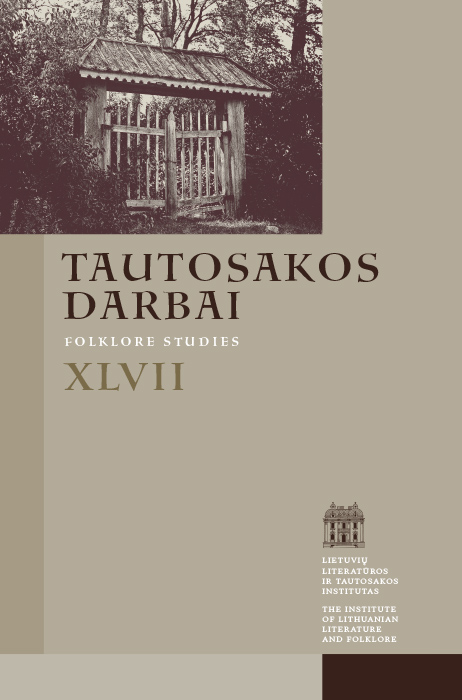Regarding Expressions of Landscape in Folksongs
Abstract
The aim of the article is revealing ways and extent of reflections of the natural Lithuanian landscape taking place in folksongs during various periods of their development. From the modern perspective it is attempted to grasp the meanings of the landscape reflections and what it used to mean to the people composing those songs. The analysis in the article is limited to just two objects of the landscape, namely, the field and the mountain as interpreted by folksongs. Survey of the poetical meanings of these two landmarks is expected to suggest the right direction towards further elucidation of patterns of the meaning construction attributed to the landscape in folksongs. The ploughlands and meadows, characterized by the most typical feature of the Lithuanian scenery – its flatness, open up in Lithuanian folksongs as form of the landscape spiritualized (cultured) by human activity. Although the social and economic contextual plane of the fields and meadows is apparently given prominence in the songs, as the main source for the farmer’s living, the poetic expression attributed to these elements of landscape enables interpreting them as representations of the peasant idyll and blissful space. Further analysis of the folksong images of the field is related to the landscape semantics based on mythic and ritual notions. Manifestations of mountain in the folksongs lend even greater prominence to the ritually motivated symbolism of landscape.
Two main conclusions are made by the author:
1) The retrospective view of the ritual memory provides the key for further deciphering of the more general and broader meanings of the poetical landscape in folksongs;
2) The historical survey of the landscape expressions used in folksongs makes it clear that only folksongs of the latest period do break free from the mythic and ritual background, which is then replaced by other kinds of meaning construction attributed to the landscape, including the patriotic one.

This work is licensed under a Creative Commons Attribution 4.0 International License.
Downloads
Most read articles by the same author(s)
- Bronė Stundžienė, From the Soviet Folksong Research: Between Free Choice and Obligation , Tautosakos darbai: Vol. 65 (2023): Tautosakos darbai
- Bronė Stundžienė, Folk Couplets against the Background of Historical Memory , Tautosakos darbai: Vol. 63 (2022)
- Živilė Ramoškaitė, Bronė Stundžienė, Looking at the Horizons of Folksong Research. Živilė Ramoškaitė interviewing Bronė Stundžienė , Tautosakos darbai: Vol. 64 (2022)
- Bronė Stundžienė, Called by Folksongs: A Book on a Folklore Ensemble , Tautosakos darbai: Vol. 57 (2019)
- Bronė Stundžienė, The Lithuanian Folk Couplets: On This Side of the Permissible Laughter and Beyond , Tautosakos darbai: Vol. 59 (2020)
- Bronė Stundžienė, The Folksong Narrative of the Family: Ritual Exposures and the Meaning of Shifting Contexts , Tautosakos darbai: Vol. 51 (2016)
- Bronė Stundžienė, Traces of Time in the History of Editing the Book of Lithuanian Folk Songs , Tautosakos darbai: Vol. 61 (2021)
- Bronė Stundžienė, Local Folk Memory in Literary Fiction: the Case of Pasvalys Region , Tautosakos darbai: Vol. 49 (2015)
- Bronė Stundžienė, Turning to the Beginning of the Lithuanian Folksong Publication , Tautosakos darbai: Vol. 56 (2018)
- Bronė Stundžienė, Rita Černiauskienė, Experiencing Ethnology while at School , Tautosakos darbai: Vol. 57 (2019)
